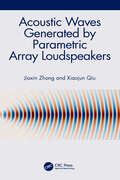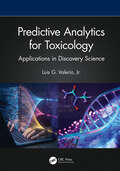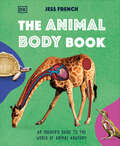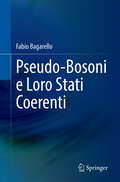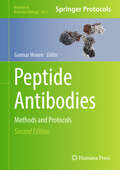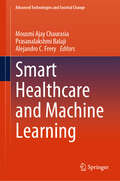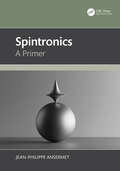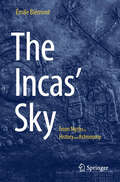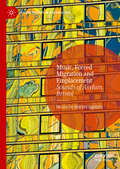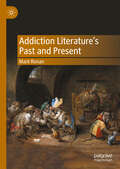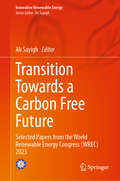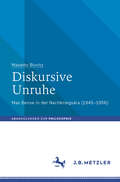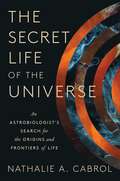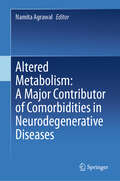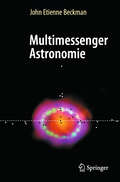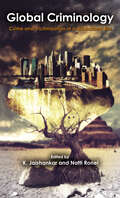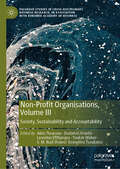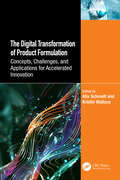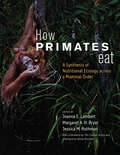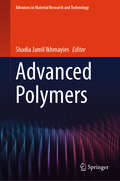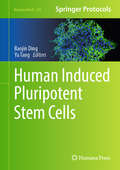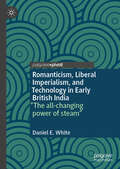- Table View
- List View
Acoustic Waves Generated by Parametric Array Loudspeakers
by Xiaojun Qiu Jiaxin ZhongParametric array loudspeakers (PALs) are capable of generating highly directional audio beams from nonlinear interactions of intense airborne ultrasound waves. This unique capability holds great potential in audio engineering. This book systematically introduces the physical principles of acoustics waves generated by PALs, along with the commonly used and the state-of-the-art numerical models, such as the Westervelt model, the convolution directivity model, the Gaussian beam expansion method, and the spherical wave expansion method.The properties of sound fields generated by PALs are analyzed. Also analyzed are various phenomena including the reflection of acoustics waves generated by PALs from a surface, transmission through a thin partition, scattering by a rigid sphere, and propagation in rooms. Furthermore, the steering and focusing of acoustics waves generated by PALs and potential applications of PALs in active sound control are investigated. Finally, the implementation issues of hardware, signal processing techniques, measurement, and safety are discussed.The book is tailored to meet the needs of researchers in this field, as well as audio practitioners and acoustics engineers.
Predictive Analytics for Toxicology: Applications in Discovery Science
by Luis G. Valerio, Jr.Predictive data science is already in use in many fields, but its application in toxicology is new and sought after by non-animal alternative testing initiatives. Predictive Analytics for Toxicology: Applications in Discovery Science provides a comprehensive overview of the application of predictive analytics in the field of toxicology, highlighting its role and applications in discovery science.This book addresses the challenges of accurately predicting high-level endpoints of toxicity and explores the use of computational and artificial intelligence research to automate predictive toxicology. It underscores the importance of predictive toxicology in proposing and explaining adverse outcomes resulting from human exposures to specific toxicants, especially when experimental and observational data on the toxicant are incomplete or unavailable.Key features: Includes a plain language description of predictive analytics in toxicology adding an overview of the wide range of applications Examines the science of prediction, computational models as an automated science and comprehensive discussions on concepts of machine learning Opens the hood on AI and its applications in toxicology Features coverage on how in silico toxicity predictions are translational science tools The book integrates strategies and practices of predictive toxicology and offers practical information that students and professionals of the toxicology, chemical, and pharmaceutical industries will find essential. It fulfills the expectations of student researchers seeking to learn predictive analytics in toxicology. This book will energize scientists to conduct predictive toxicology modeling using artificial intelligence and machine learning, and inspire students and seasoned scientists interested in automated science to pick up new research using predictive in silico models to evaluate chemical-induced toxicity.With its focus on practical applications and real-world examples, this book serves as a guide for navigating the complex issues and practices of discovery toxicology. It is an essential resource for those interested in computer-based methods in toxicology, providing valuable insights into the use of predictive analytics.
The Animal Body Book: An Insider's Guide to the World of Animal Anatomy
by Jess FrenchAnimals come in all shapes and sizes, and they are just as different on the inside as they are on the outside. Join children’s author and vet Dr. Jess French and explore how animal bodies work, and the amazing things they can do.Animals perform extraordinary feats every day, from breathing underwater to flying, but how do they do these amazing things? The answers lie in the miraculous forms and features of their bodies. Look under the skin of all sorts of animals to see how their different organs help them to survive and thrive. From a whale’s enormous heart and an owl’s sensitive ears to a tortoise’s tough shell and an insect’s unusual eyes, explore more than 40 animal adaptations in close detail. With nine chapters covering skeletons, circulation, digestion, the senses and more, every aspect of anatomy is covered, all clearly explained by animal expert Dr. Jess French. Stunning photography combined with cutaway illustrations reveal what each species looks like inside, and colorful diagrams help support understanding. The Animal Body Book is a friendly introduction to animal anatomy, perfect for any child fascinated by animals or budding veterinarians.
Urban Coyotes (Scientists in the Field)
by Mary Kay CarsonA new addition to the acclaimed Scientists in the Field series, Urban Coyotes follows the scientists of the Urban Coyote Research Project as they track, study, and care for coyotes living among humans in one of America's largest cities, Chicago.But that’s the thing about coyotes. They don’t necessarily do what’s typical or usual, nor what’s expected or predicted. Coyotes are rule breakers. The fourth largest metropolitan area in North America is home to more than nine million people and a surprisingly large population of coyotes. Join the wildlife scientists of the Urban Coyote Research Project as they carry on their twenty-five-year mission: Studying the coyotes of Cook County, Illinois, home to the city of Chicago. Explore questions such as "Where did the coyotes come from—and why?," "Are they a danger to Chicagoans?," and "Do predators create healthier urban ecosystems?" with real-life scientists in the field. Started by urban ecologist Stan Gehrt in the late 1990s when coyotes were first noticed entering the Chicago region, the Urban Coyote Research Project's mission is to help coyotes and human city dwellers live together in peace.With stunning up-close photography by Tom Uhlman, author Mary Kay Carson offers an in-depth look into how these mystifying wild creatures, and those dedicated to studying and protecting them, navigate urban spaces.
CNS Drug Development and Delivery: Concepts and Applications (AAPS Introductions in the Pharmaceutical Sciences #9999)
by Alan TaleviThe book covers recent advances in the field of CNS therapeutics, including opportunities posed by expanding basic knowledge related to CNS conditions and novel approaches for efficient drug delivery to the brain (e.g., pharmaceutical nanocarriers and transporter- and transcytosis-mediated drug delivery to the brain inhibition of the blood-brain barrier). Chapters dealing with state-of-the-art in silico and in vitro tools for predictive purposes related to CNS bioavailability are also be included. This is an ideal book for undergraduate students and graduates in the field of medicine and pharmaceutics, and professionals working in the field of brain disorders.
Pseudo-Bosoni e Loro Stati Coerenti
by Fabio BagarelloL'analisi proposta in questo libro si focalizza su particolari deformazioni delle regole di commutazione canoniche suggerite dal recente, e sempre crescente, interesse per la meccanica quantistica PT-simmetrica. Se ne considerano diverse conseguenze di natura matematica, ma anche loro possibili applicazioni alla fisica. Queste includono l'analisi di diverse Hamiltoniane non autoaggiunte, il calcolo di integrali di cammino associati a tali Hamiltoniane per mezzo di stati bi-coerenti, ed una nuovo punto di vista sugli operatori posizione e momento. Il libro è prevalentemente destinato ai ricercatori ma è anche pensato per essere fruibile da studenti di magistrale e di dottorato. Fornisce inoltre una introduzione ad alcuni aspetti delicati dell'analisi funzionale e della meccanica quantistica per osservabili non autoaggiunte.
Peptide Antibodies: Methods and Protocols (Methods in Molecular Biology #2821)
by Gunnar HouenThis detailed new edition explores current methods for the production and use of peptide antibodies. The book delves into various aspects of peptide synthesis and analysis, peptide-carrier conjugation, epitope and paratope prediction and identification, as well as improved assays and other uses of peptide antibodies. Written for the highly successful Methods in Molecular Biology series, chapters include introductions to their respective chapters, lists of the necessary materials and reagents, step-by-step and readily reproducible laboratory protocols, and tips on troubleshooting and avoiding known pitfalls. Authoritative and up-to-date, Peptide Antibodies: Methods and Protocols, Second Edition serves as an ideal reference for researchers exploring this vital and expansive area of study.
Smart Healthcare and Machine Learning (Advanced Technologies and Societal Change)
by Alejandro C. Frery Mousmi Ajay Chaurasia Prasanalakshmi BalajiThe book explores the convergence of healthcare and cutting-edge technology, making it a captivating subject for readers interested in future research. Smart healthcare with machine learning techniques offers a transformative paradigm that utilizes the power of new technology, data analytics, and interconnected devices to enhance the quality, efficiency, and accessibility of healthcare services. This involves leveraging Internet of Things (IoT) devices, wearable technology, and machine learning algorithms to monitor patient health, predict medical conditions, and offer personalized treatment recommendations. This innovative combination not only enhances diagnostics and treatment but also addresses the research challenges of healthcare access and delivery in an increasingly connected world. By exploring the synergy between smart healthcare and machine learning, the book helps to understand how these technologies can collaborate to revolutionize patient care and healthcare delivery. This book is an outcome with applications of future technologies to overcome the toughest humanitarian challenges from an engineering approach.
Evidence!: How Dr. John Snow Solved the Mystery of Cholera
by Deborah HopkinsonThe incredible true story of the doctor who traced London's cholera outbreak to a single water pump, and went on to save countless lives through his groundbreaking research!Dr. John Snow is one of the most influential doctors and researchers in Western medicine, but before he rose to fame, he was just a simple community doctor who wanted to solve a mystery.In 19th century London, the spread of cholera was as unstoppable as it was deadly. Dr. Snow was determined to stop it, but he had a problem: His best theory of how the disease was spread flew in the face of popular opinion. He needed evidence, and he needed to find it fast, before more lives were lost.Taking on the role of detective as well as doctor, Dr. Snow knocked on doors, asked questions and mapped out the data he'd collected. What he discovered would come to define the way we think about public health to this day.This compelling nonfiction picture book is a timely reminder of the power of science to save lives.
Spintronics: A Primer
by Jean-Philippe AnsermetA sound understanding of magnetism, transport theory, spin relaxation mechanisms, and magnetization dynamics is necessary to engage in spintronics research. In this primer, special effort has been made to give straightforward explanations for these advanced concepts.This book will be a valuable resource for graduate students in spintronics and related fields. Concepts of magnetism such as exchange interaction, spin-orbit coupling, spin canting, and magnetic anisotropy are introduced. Spin-dependent transport is described using both thermodynamics and Boltzmann’s equation, including Berry curvature corrections. Spin relaxation phenomenology is accounted for with master equations for quantum spin systems coupled to a bath. Magnetic resonance principles are applied to describe spin waves in ferromagnets, cavity-mode coupling in antiferromagnets, and coherence phenomena relevant to spin qubits applications.Key Features:• A pedagogical approach to foundational concepts in spintronics with simple models that can be calculated to enhance understanding.• Nineteen chapters, each beginning with a historical perspective and ending with an outlook on current research.• 1200 references, ranging from landmark papers to frontline publications.
The Incas' Sky: From Myths to History and Astronomy
by Émile BiémontThis book introduces readers to the astonishing civilisation of the Incas. Its novelty lies in its general but highly informative synthesis of their history and astronomy through the accounts of contemporary chronicles and recent archaeological findings. Richly illustrated with the author’s own photographs, it will attract the attention of seasoned travellers interested in ancient civilisations and keen to discover what people were capable of achieving so long ago, but also any reader interested in the history and prehistory of South American peoples, including students or university researchers wanting to know more about the pre-Columbian civilizations of Peru. The Inca civilisation was in fact the culmination of cultural contributions from a dozen or so complex pre-Columbian civilizations, such as those of Chavín, Nazca, Wari, or Tiwanaku. Intensely spiritual, the Inca people attributed metaphysical powers to all manner of objects and places they considered sacred, but at the same time the numerous alignments in their buildings show that they result from careful observations of the Sun, the Moon, and the stars at different times of the year. Indeed, the Incas were an essentially agrarian people, so time measurement and calendar devices were essential for the purely pragmatic problem of planning agricultural tasks during the tropical year. The book sets out to describe the Incas in their historical and geographical context, avoiding specialization or excessive technicality, but retaining a certain scientific rigor, and including a detailed consideration of their interest in the sky and astronomy.
Music, Forced Migration and Emplacement: Sounds of Asylum Bristol (Leisure Studies in a Global Era)
by Nicola De Martini UgolottiThis book analyses the negotiation of place, belonging and uncertainty enacted by a group of 60 men and women seeking asylum who gathered weekly in a community space in Bristol, UK, to share songs, memories, laughter, and precariousness with other established and new city-dwellers. Building on a rich corpus of ethnographic data, this book explores music-making to address “what goes unnoticed” in existing ways of thinking about forced migration. By looking at the junctures where leisure, forced migration and urban analyses intersect with grassroot solidarity with and by people seeking asylum, it offers an interdisciplinary reading of music, forced migration and emplacement for scholars across leisure, anthropology, sociology, and geography. This book contributes and provokes novel discussions regarding refugees’ everyday experiences and negotiations of precariousness, suspension, and marginality in Britain.
Addiction Literature's Past and Present
by Mark RonanAddiction Literature's Past and Present aims to realign consideration of addiction as a transhistorical and transcultural aspect of the human condition. This book illuminates the premodern roots of the linguistic and narrative materials of addiction discourse and argues for Addiction Literature to be considered as a distinct literary phenomenon, with a history stretching back to Antiquity. Addiction, as it is understood in this book, exists at the intersection between appetite, habit and impaired personal behavioural agency. This book begins by exploring the ways in which we articulate the experience (both lived and observed) of addiction today, uncovering a core set of conceptual components and discursive tropes which are commonly associated with modern understandings of the phenomenon. Having established a common set of tropes and features which distinguish modern Addiction Literature as a distinct literary mode, it then considers premodern texts through this lens, revealing similar patterns of conception and convention in a broad range of historical periods and literary genres from Aesop to Shakespeare.
Transition Towards a Carbon Free Future: Selected Papers from the World Renewable Energy Congress (WREC) 2023 (Innovative Renewable Energy)
by Ali SayighThis book contains selected papers from the 22nd World Renewable Energy Congress (WREC 2023) in Kuala Lumpur. The forum promotes renewable energy global development and features top international experts, policymakers, scientists, engineers, technology developers, and business practitioners addressing the most current research in sustainable energy development and innovation. The contributions address policy, technology, and applications across a wide range of topics, including solar thermal, geothermal energy, wind energy, turbines and generators, bioclimatic architecture, energy audits, construction and design, low carbon mobility, green steel, batteries and supercapacitors, regulatory issues and public policy, circular economy, urban mining and much more.
Diskursive Unruhe: Max Bense in der Nachkriegsära (1945–1956) (Abhandlungen zur Philosophie)
by Masetto BonitzMax Bense (1910–1990) suchte in der Nachkriegsära entschieden die Öffentlichkeit. Er war Diskursträger und eine Persönlichkeit, die polarisierte. Dennoch geriet er in eine offensichtlich merkwürdige Vergessenheit, die seinem Werk, seiner Persönlichkeit und der geschichtlichen Entwicklung nicht gerecht wird. Dieses Buch befasst sich eingehend mit dem im Deutschen Literaturarchiv Marbach liegenden Nachlass Max Benses und fokussiert insbesondere auf den Briefeschreiber und -empfänger in der Nachkriegsära (1945–1956). Dabei wird sichtbar, was in dieser Zeit kulturpolitisch als auch geistesgeschichtlich verhandelt wurde und was für deutsche Gelehrte, Intellektuelle und Schriftsteller auf dem Spiel stand. Bense agierte in Diskursen der Philosophie, Literatur, Kunst und Politik, wobei er gegen erhärtete Machtstrukturen vorging und seine Umwelt beunruhigte. Er verfasste eine Vielzahl kritischer Beiträge für Zeitungen, Zeitschriften und Sammelbände, die symptomatisch für die Nachkriegszeit waren. Sie transportieren dabei oftmals politische Dimensionen, durch die Stimmungen der frühen Nachkriegsjahre und der Adenauerzeit sichtbar werden.
The Secret Life of the Universe: An Astrobiologist's Search for the Origins and Frontiers of Life
by Nathalie A. CabrolOne of the world&’s leading astrobiologists takes us on an awe-inspiring journey across the cosmos to investigate some of humanity&’s most profound questions: Are we alone in the universe? And, how did life on Earth begin?We are in a golden age in astronomy, living on the cusp of breakthroughs that will revolutionize our understanding of our place in the cosmos in. Yet a profound question remains: Are we alone in the universe? We have never been closer to answering this question. In The Secret Life of the Universe, astrobiologist and the director of the Carl Sagan Center at the SETI Institute Nathalie A. Cabrol takes us to the frontiers of the search for life. The book&’s odyssey begins by exploring how life began on Earth in order to understand what&’s necessary for its existence elsewhere. What role did our Moon play? And could life on Mars have seeded life on Earth? Cabrol continues this dazzling interplanetary tour, illuminating the likeliest places for life in our neighborhood: While Mars and the icy moons of Jupiter and Saturn are among the top contenders, recent missions are redefining the limits of habitability to include unexpected worlds. Finally, we seek life beyond our Solar System, becoming witness to a revolution in the night sky: the realization that there are as many planets as stars in our galaxy. With more than 300 million exoplanets in the habitable zone of their stars in the Milky Way alone, to think we are alone, or the only advanced intelligent civilization, may be little more than nonsense. The Secret Life of the Universe is a comprehensive and authoritative guide to the search for life. This is an exhilarating journey for anyone who has ever looked up at the stars and wondered what might be out there.
Altered Metabolism: A Major Contributor of Comorbidities in Neurodegenerative Diseases
by Namita AgrawalThis book presents a systematic and extensive understanding about metabolic alterations affecting multiple aspects of different neurodegenerative diseases (NDDs), such as Alzheimer’s, Parkinson’s, Huntington’s disease, SCAs, SBMA, DRPLA, ALS, Freidrich Ataxia etc. The book also illustrates cellular and molecular mechanisms behind the key neurodegenerative diseases and further expands on concept of unique and developing biomarkers associated with the onset and progression of NDDs. Additionally, it elaborates on the concept of latest imaging tools to monitor state of NDDs and accordingly develop therapeutic approaches entailing phytochemicals in the management of metabolic alterations associated with NDDs that ultimately suppresses course of devastating NDDs. The book aids to improve the overall understanding about the NDD and involvement of metabolic disorder as a major factor for indisposition of the disease. Therefore, suggesting that targetting metabolic variations by phytochemicals can combat NDD related symptoms for the betterment of impacted patients. While introducing cellular and molecular mechanisms and the treatment regimen under the umbrella of metabolism in several NDDs, the book covers major aspects of understanding the metabolic basis of NDDs, its implications, and treatment. This will inflate the readers' understanding about this particular area and guide those working in this domain, be it a researcher or clinicians,to choose or design effective therapeutic strategies to curb metabolic alterations linked with these disorders. This book will not only contribute towards improving the overall state of the challenged individuals but will also bring new hope towards improving the quality of lives of affected patients.
Multimessenger Astronomie
by John Etienne BeckmanDieses Buch wurde von einem professionellen Astronomen geschrieben, der im Laufe seiner Karriere an einem breiten Spektrum von Themen gearbeitet hat, und bietet eine populärwissenschaftliche Beschreibung dessen, was als Multimessenger-Astronomie bekannt geworden ist. Es verbindet das Neue mit dem Traditionellen und zeigt, wie sich die Astronomie in der modernen Ära immer schneller weiterentwickelt hat. Im zweiten Jahrzehnt des einundzwanzigsten Jahrhunderts hat die Astronomie den Beginn einer Revolution erlebt. Nachdem wir jahrhundertelang alle Informationen über das Universum mittels elektromagnetischer Wellen erhalten haben, gibt es nun mehrere völlig neue Möglichkeiten, es zu erforschen. Am spektakulärsten war der Nachweis von Gravitationswellen im Jahr 2015, aber die Astronomie nutzt auch Neutrinos und Teilchen der kosmischen Strahlung, um die Vorgänge in den Zentren von Sternen und Galaxien zu untersuchen. Das Buch ist stark auf Messungen und Beobachtungstechnik ausgerichtet. Es ist reichlich mit farbigen Bildern von Instrumenten, ihren Entwicklern und astronomischen Objekten illustriert und wird durch Beschreibungen der zugrunde liegenden Theorien und Konzepte ergänzt, die Vorhersagen, Beobachtungen und Experimente miteinander verbinden. Der rote Faden ist weitgehend historisch, obwohl er natürlich nicht enzyklopädisch sein kann. Es deckt die Entwicklungen der Astronomie des zwanzigsten Jahrhunderts bis Ende 2020 so vollständig wie möglich ab. Das Buch richtet sich an ein breites interessiertes Publikum und Leser populär-wissenschaftlicher Magazine. Ein tieferes Verständnis von Physik ist nicht erforderlich.
Global Criminology: Crime and Victimization in a Globalized Era
by K. Jaishankar Natti RonelGlobal criminology is an emerging field covering international and transnational crimes that have not traditionally been the focus of mainstream criminology or criminal justice. Global Criminology: Crime and Victimization in a Globalized Era is a collection of rigorously peer-reviewed papers presented at the First International Conference of the So
Non-Profit Organisations, Volume III: Society, Sustainability and Accountability (Palgrave Studies in Cross-disciplinary Business Research, In Association with EuroMed Academy of Business)
by Leonidas Efthymiou Demetris Vrontis Yaakov Weber Alkis Thrassou Evangelos Tsoukatos S. M. Riad ShamsThis four-volume book examines, through multiple and cross-discipline perspectives, the science and practice of not-for-profit organisations. These organisations have drawn considerable attention and witnessed extensive growth as they engage in delivering public services to society. And are increasingly pressured to balance business with social goals, inherent idiosyncratic features with management creativity, structural limitations with operational flexibility, and ethical boundaries with pragmatism; all with scarce resources but abundant determination. The first volume explores the opportunities and challenges of non-profit organisations in the contemporary environment, elucidating current and future issues in the field, setting strategic directions, and presenting sector-wide examples and best practices. The second volume explores contextual aspects relating to the economy and industries. The third volume presents social and ethical aspects, as well as matters of sustainability, accountability and the overall wellbeing of society. The fourth and final volume examines structures and models, with an emphasis on technology.
The Digital Transformation of Product Formulation: Concepts, Challenges, and Applications for Accelerated Innovation
by Alix Schmidt Kristin WallaceIn competitive manufacturing industries, organizations embrace product development as a continuous investment strategy since both market share and profit margin stand to benefit. Formulating new or improved products has traditionally involved lengthy and expensive experimentation in laboratory or pilot plant settings. However, recent advancements in areas from data acquisition to analytics are synergizing to transform workflows and increase the pace of research and innovation. The Digital Transformation of Product Formulation offers practical guidance on how to implement data-driven, accelerated product development through concepts, challenges, and applications. In this book, you will read a variety of industrial, academic, and consulting perspectives on how to go about transforming your materials product design from a twentieth-century art to a twenty-first-century science. Presents a futuristic vision for digitally enabled product development, the role of data and predictive modeling, and how to avoid project pitfalls to maximize probability of success Discusses data-driven materials design issues and solutions applicable to a variety of industries, including chemicals, polymers, pharmaceuticals, oil and gas, and food and beverages Addresses common characteristics of experimental datasets, challenges in using this data for predictive modeling, and effective strategies for enhancing a dataset with advanced formulation information and ingredient characterization Covers a wide variety of approaches to developing predictive models on formulation data, including multivariate analysis and machine learning methods Discusses formulation optimization and inverse design as natural extensions to predictive modeling for materials discovery and manufacturing design space definition Features case studies and special topics, including AI-guided retrosynthesis, real-time statistical process monitoring, developing multivariate specifications regions for raw material quality properties, and enabling a digital-savvy and analytics-literate workforce This book provides students and professionals from engineering and science disciplines with practical know-how in data-driven product development in the context of chemical products across the entire modeling lifecycle.
How Primates Eat: A Synthesis of Nutritional Ecology across a Mammal Order
by Alison RichardExploring everything from nutrients to food acquisition and research methods, a comprehensive synthesis of the study of diet and feeding in nonhuman primates. What do we mean when we say that a diet is nutritious? Why can some animals get all the energy they need from eating leaves while others would perish on such a diet? Why don’t mountain gorillas eat fruit all day as chimpanzees do? Answers to these questions about food and feeding are among the many tasty morsels that emerge from this authoritative book. Informed by the latest scientific tools and millions of hours of field and laboratory work on species across the primate order and around the globe, this volume is an exhaustive synthesis of our understanding of what, why, and how primates eat. State-of-the-art information presented at physiological, behavioral, ecological, and evolutionary scales will serve as a road map for graduate students, researchers, and practitioners as they work toward a holistic understanding of life as a primate and the urgent conservation consequences of diet and food availability in a changing world.
Advanced Polymers (Advances in Material Research and Technology)
by Shadia Jamil IkhmayiesThis book delves into a wide array of polymer topics, covering synthesis methods, processing technologies, performances, advanced characterization, and modeling techniques. It highlights recent advancements in polybenzoxazine-based smart shape memory materials, metallopolymer, HCN derived polymers. Advanced polymer composites, polymeric nanomaterials, and their fabrication methods and applications are also discussed. Additionally, the book explores the utilization of emerging polymer materials in biosensor development, covering various classes such as biopolymers, functional polymers, hydrogels, conductive polymers, and nanomaterials. It provides insights into the recent advances in polyaniline copolymers for chemical sensors and cellulose nanocrystals (CNC) and cellulose nanofibers (CNF)-based pickering emulsions with antimicrobial properties, particularly focusing on applications in food and biomedical products. Furthermore, it delves into polydisperse polymer brushes under compression, detailing their behavior concerning polymer persistence length and substrate stiffness.
Human Induced Pluripotent Stem Cells (Neuromethods #210)
by Baojin Ding Yu TangThis volume explores the latest developments in the field and showcases the vast potential of human induced pluripotent stem cells (hiPSCs) in advancing neuroscience research. The chapters in this book are organized into three parts. Part One describes the generation, characterization, and validation of hiPSCs using different methodologies from various resources. Part Two focuses on techniques for genome editing of hiPSCs. Part Three covers various hiPSC applications in neuroscience research and strategies for analyzing hiPSC-based model systems. These applications include the generation of neural subtypes, glial cells, and skeletal muscles; assembling co-culture systems to prepare highly pure neurons at late maturation stages; measuring nuclear transport of proteins and transcripts in cultured neurons; and generating brain organoids. In the Neuromethods series style, chapters include the kind of detail and key advice from specialists needed to achieve successful results in your laboratory. Cutting-edge and comprehensive, Human Induced Pluripotent Stem Cells is a valuable resource for researchers and students in neuroscience, neurology, stem cell biology, and other related fields.
Romanticism, Liberal Imperialism, and Technology in Early British India: “The all-changing power of steam”
by Daniel E. WhiteConsidering metropolitan and colonial cultural production as a “unitary field of analysis,” this book shows how tensions in the 1830s between utilitarian and Romantic perspectives on steam power marked meaningful divisions within the pervasive liberal imperialism of the period and generated divergent speculative fantasies, set in the twentieth and twenty-first centuries, about the future of Indian nationalism. Poetry and fiction in Britain and Bengal engage with a Romantic strain of thought and sentiment according to which steam technology represents an anti-utilitarian humanization of nature. Within and against that frame and in uneven and different ways, writers in British India map a constellation of liberal values onto their hopes and fears concerning a future powered by steam.
